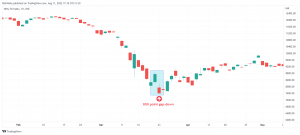Chapter 2
Why you should consider opting for Options?
Options are an essential tool in a trader’s arsenal. In this chapter, we will compare equity, futures, and options on various key parameters to help you learn about options and its utility to a trader.
Trend suitability
If you analyse Nifty50’s historical data, you will see that it does not always move up. A look at the recent data indicates that on average, five months in a year, the market is either trending down or moving sideways.
Table 1: Nifty50’s movement
| No. of months | 2021 | 2020 | 2019 | 2018 | 2017 |
| Up (more than +0.5%) | 7 | 7 | 7 | 5 | 8 |
| Down (more than -0.5%) | 2 | 5 | 3 | 4 | 4 |
| Sideways (Between -0.5% to 0.5%) | 3 | 0 | 2 | 3 | 0 |
| Total months | 12 | 12 | 12 | 12 | 12 |
It means that trading only in equity shares may not always work. When you trade equity shares, you only profit when the share price moves up (we are not considering intraday trading or the profit from dividends for this discussion).
Similarly, with futures (a derivative instrument like options), you only profit when the market moves up or down.
Table 2: Options: A ‘friend for every trend’
| Equity | Futures | Options | |
| Profitable in uptrend | ✅ | ✅ | ✅ |
| Profitable in downtrend | ❌ | ✅ | ✅ |
| Profitable in the sideways market | ❌ | ❌ | ✅ |
Note: We are not considering intraday equity trading for this discussion.
In contrast, options give a trader tremendous flexibility and can potentially deliver profits whether markets are trending up, down, or sideways.
Capital requirement
Options are also extremely capital efficient and deliver higher returns on investment than other instruments. Let’s see this with an example.
Let’s say you believe that Reliance Industries could rise from its current price of ₹2,580. You expect it to reach ₹2,600 in a day. To benefit from this, you could buy Reliance shares, Reliance Futures, or Reliance Options. Here is the capital requirement for each of the instruments:
Table 3: Options have a low capital requirement
| Buy Shares* | Buy Futures | Buy Options** | |
| Quantity (shares/one lot size) | 250 | 250 | 250 |
| Buy price (₹) | 2580 | 2585 | 55 |
| Total Capital/Margin/Premium (₹) | 6,45,000 | 1,46,690 | 13,750 |
*Shares bought without margin trading facility (MTF).
**Reliance 2580 Call option.
Return on investment (ROI)
You expected Reliance to rise to ₹2600, and it did! Since your target has been met, you decide to close your position. Here is how the profit and ROI under each instrument would be:
Table 4: Options could deliver very high ROI
| NIFTY50 | Buy Shares* | Buy Futures | Buy Options** |
| Sell price (₹) | 2600 | 2605 | 72 |
| Profit (₹) | 5000 | 5000 | 4250 |
| Return on investment (%) | 1% | 3% | 31% |
*Shares bought without margin trading facility (MTF).
**Reliance 2580 Call option.
While a 31% return in a day from options trading looks astonishing, it is possible. Further, successive winning trades can have a strong compounding effect on the capital. However, high returns come with high risk. There is also a fair chance one could lose the entire premium invested if, in the above example, the Reliance stock had closed below 2580 on the expiry day.
Pre-defined payoffs
With most options strategies, you can cap your returns in profit and loss. This helps in two ways.
- You know the exact risk and reward before taking the trade.
- In the event of a big gap-up or gap-down opening, the payoffs won’t change. More importantly, the losses will be capped. In contrast, the losses could be dramatic in equity or futures positions in such a scenario.
Imagine a trader who expects the Nifty to rise and buys one lot of Nifty futures on March 20, 2020 (Friday) at 8,745. He has decided on a stop loss of 8,645 (i.e. 100 points lower). This translates into a risk of ₹5,000 (50 qty * 100 points).
On March 23, 2020 (Monday), Nifty50 started with a gap-down. It opened 800 points lower. This was a day before the lockdown was announced in India.
Illustration 1: Nifty50 Daily chart

Source: Tradingview
Our trader holding the Nifty futures position, who had budgeted for a risk of ₹5,000, is now staring at a loss of ₹40,000. Compared to this, a holder of an options strategy (say, bull call spread) would have also suffered a loss, albeit capped at a much lower amount, say around ₹7,000.
To Conclude:
- Options can potentially deliver profits in a bull market, a bear market and even when the market moves sideways.
- As compared to shares or futures, options have a low capital requirement and deliver a higher return.
- These high returns come with high risk. One could potentially lose the entire capital.
- Options strategies enable you to know the exact risk and reward before taking the trade.
What it means is that if you are able to control the risks associated with options, you could potentially trade in any market situation with lower capital and can generate high returns on your capital. Sounds too good to be true? Well, it isn’t. But it comes with a learning curve. That said, we are here to help you get your basics in place.
Turn to the next chapter and begin your Options journey by understanding the basics of Call options.

Test your OQ (Options Quotient)
Take your first step towards financial independence with the right training.



